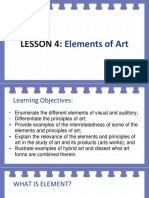0% found this document useful (0 votes)
247 views6 pagesBasic Elements of Arts
The basic elements of art include line, shape, form, space, color, and texture. Line is a continuous mark that can be horizontal, vertical, curved, or zigzag to convey different meanings. Shape is defined in two dimensions while form exists in three dimensions with height, width, and depth. An artist uses space, color, and texture to create depth and set a mood in a work of art.
Uploaded by
Louievie May Estorosas SajulgaCopyright
© © All Rights Reserved
We take content rights seriously. If you suspect this is your content, claim it here.
Available Formats
Download as PDF, TXT or read online on Scribd
0% found this document useful (0 votes)
247 views6 pagesBasic Elements of Arts
The basic elements of art include line, shape, form, space, color, and texture. Line is a continuous mark that can be horizontal, vertical, curved, or zigzag to convey different meanings. Shape is defined in two dimensions while form exists in three dimensions with height, width, and depth. An artist uses space, color, and texture to create depth and set a mood in a work of art.
Uploaded by
Louievie May Estorosas SajulgaCopyright
© © All Rights Reserved
We take content rights seriously. If you suspect this is your content, claim it here.
Available Formats
Download as PDF, TXT or read online on Scribd
/ 6




















































































